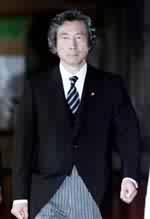 |
Japanese PM Visits Yasukuni Shrine Despite Opposition

Japan's Prime Minister Visits Yasukuni Shrine
Japanese Prime Minister Junichiro Koizumi visited Tokyo's Yasukuni Shrine Monday afternoon to pay homage to Japan's war dead including 14 Class-A war criminals despite strong opposition both at home and abroad.
Koizumi made the visit shortly after 4:30 p.m. (local time), becoming the first serving Japanese prime minister in five years to visit the Shinto shrine, which is controversial because convicted war criminals are among those honored there.
"I have said before that visiting Yasukuni Shrine is an expression of Japan's pledge to peace. But it became gradually clear that the visit could be taken to have the opposite meaning if it was made on August 15," Koizumi told reporters after the visit.
Koizumi had been contemplating whether to keep his pledge to visit the shrine on August 15, the 56th anniversary of Japan's surrender in World War II, after facing mounting calls from Japan' s Asian neighbors and even from officials of his ruling coalition to reconsider the plan.
"If the visit to Yasukuni Shrine on the anniversary of the end of the war is to bring suspicion to people at home and abroad over Japan's stance of rejecting war and placing importance on peace, it is something I do not wish," Koizumi said in a statement released prior to his visit.
While campaigning in the LDP presidential race in April and the House of Councillors election last month, Koizumi repeatedly said he would visit the Shinto shrine on the August 15 anniversary.
Koizumi's plan not only met strong opposition from South Korea, China and other Asian countries, but also had divided public opinion in Japan.
Koizumi decided to move up the date of the visit to Monday afternoon after holding talks with LDP Secretary General Taku Yamasaki and Chief Cabinet Secretary Yasuo Fukuda, Fukuda told a press conference.
In the statement, the Japanese prime minister said he thinks Japan should never repeat the mistake of going to war, and that he hopes to hold talks with Chinese and South Korean officials as soon as possible to explain his reasons behind the visit.
Koizumi's visit to the shrine not only outraged Japan's Asian neighbors, but also was criticized at home.
Takenori Kanzaki, leader of the New Komeito party, which is one coalition partner of the ruling Liberal Democratic Party (LDP), issued a statement criticizing Koizumi's visit.
"The visit could come close to a violation of the constitutional separation of state and religion," Kanzaki said.
"We feel really chagrined about the premier's visit because we had requested time and time again he heed diplomatic consequences, " he said.
Meanwhile, three opposition parties also criticized Koizumi's visit to the shrine.
"I'm infuriated because (Koizumi) took vague measures to avoid (visiting the shrine) on August 15," said Yukio Hatoyama, leader of the main opposition Democratic Party of Japan (DPJ).
Kazuo Shii, chairman of the Japanese Communist Party (JCP), called the visit "an immeasurable blow to the friendship between Asia and Japan."
Social Democratic Party (SDP) leader Takako Doi said it was " obvious" that Koizumi's visit to Yasukuni violated Article 20 of the Constitution stipulating freedom of religion and Article 89 separating religion and the state.
The Yasukuni shrine, a bastion of the wartime government- sponsored Shintoism and symbol of militarism in Japan before and during World War II, houses the memorial tablets of 14 Class-A war criminals, including wartime personnel and officials who have died since 1853 in Japan's various wars.
The shrine, first established in 1869, was the main shrine of state Shintoism, which is closely associated with the rise of Japan's militarism.
While some Japanese prime ministers have made visits to the shrine on August 15 after the end of World War II, the practice stopped after then Prime Minister Yasuhiro Nakasone made a visit in 1985 and drew sharp responses from neighboring countries.
In 1996, then Japanese Prime Minister Ryutaro Hashimoto made a visit to the shrine on his birthday, July 29, and also sparked criticism from Japan's neighboring countries.

In This Section

|